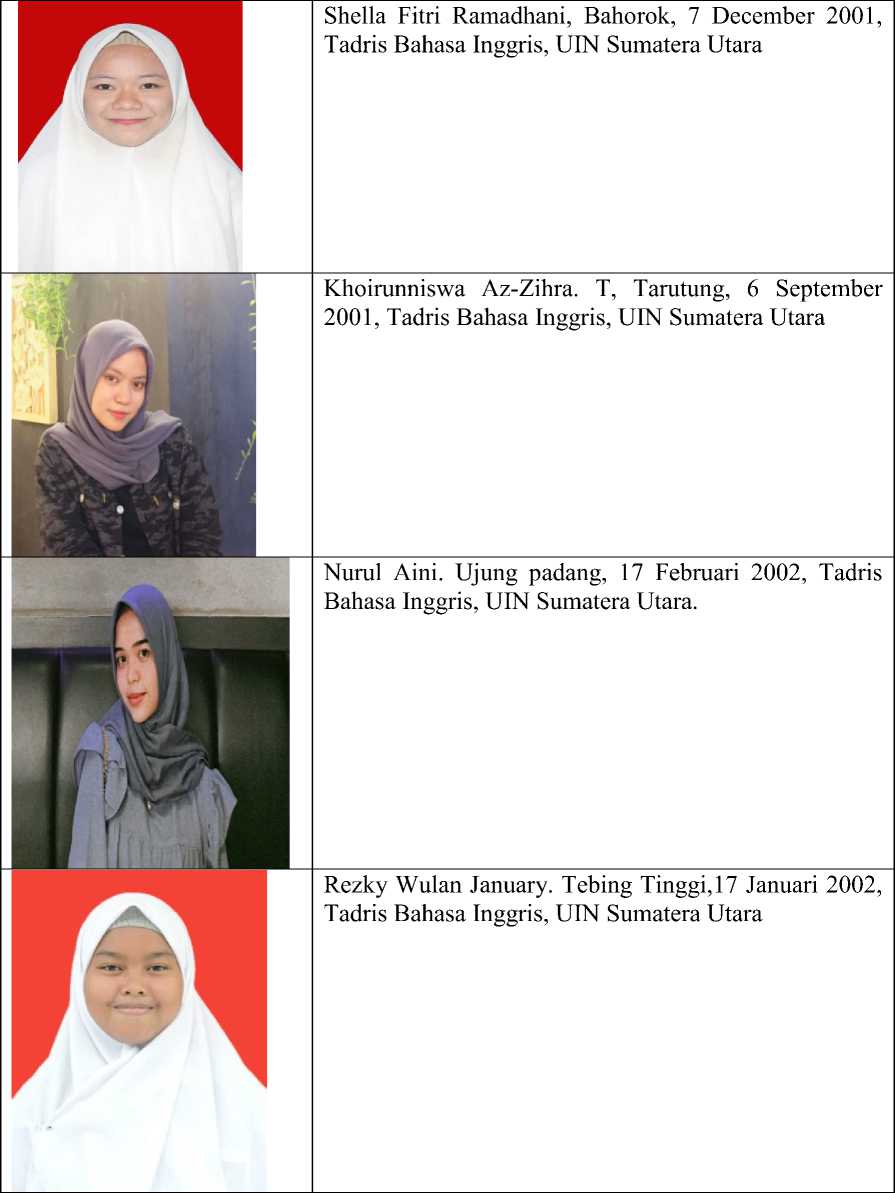A Deixis Analysis of Song Divide by Ed Sheeran
on

EE≡≡≡
e-Journal of Linguistics

Available online at https://ojs.unud.ac.id/index.php/eol/index
Vol. 17, No. 1, January 2023, pages: 93--99
Print ISSN: 2541-5514 Online ISSN: 2442-7586
https://doi.org/10.24843/e-jl.2022.v17.i01.p11
A Deixis Analysis of Song "Devide" by Ed Sheeran
-
1 Nurul Aini, 2Khoirunniswa Az-Zihra. T, 3Shella Fitri Ramadhani, 4Rezky Wulan Januari, 5Emeliya Sukma Dara
-
1 nurulainipiw@gmail.com, 2 khoirunniswa.azzihra09@gmail.com 3sellavivo08@gmail.com, 4wulanrezky17@gmail.com, 5emeliya@uinsu.ac.id
UINSU, Indonesia
Article info
Received Date: 20 June 2022
Accepted Date:1 July 2022
Published Date: 31 January 2023
Keywords:*
Deixis, Song, and Lyrics
Abstract*
The purpose of this research is to identify the type of Deixis and find the type of Deixis that is generally mastered in the lyrics of the song Ed Sheeran Divide. This includes the type of qualitative research. This research uses observation method. The data collection method uses listening & analyzing the song “Divide” by Ed Sheeran. The results of this study found that all types of deixis were direct (68 dates ), location (4 dates), & time (1 dates). Deixis is included on the lyrics to Ed Sheeran's song Divide. People's deixis is often found in Ed Sheeran's Divide lyrics. The most common types of deixis found in this study were me and people deixis, such as me. The most generic plural deixis is Sie using loose 20. Deixis serves to tell the role contained in the lyrics. The effect of using Person Deixis is to choose who is referred to in song lyrics. Locale deixis is used to tell where or where the lyric incident took place.The effect of local deixis is to create the same interpretation of the location of the incident in the song lyrics. Deixis when used in the lyrics to tell when the incident occurred. The effect according to clock deixis is to emphasize that an incident has occurred or has already occurred.
biology and history. Not only did music confer the process and ability to experience music (Levitin in Piragasam, dkk: 2013), but music was also used to extend human life (Dissanayakein
Piragasam, dkk: 2013). In addition, many lyrics also inspire life. Therefore, when listening to lyrics, we may try to understand not only the meaning of the lyrics themselves, but also the meaning of the reader or speaker. The study of speaker meaning or speaker meaning is called pragmatics. Yule (1996: 3) argued that pragmatics was related to the study of meaning conveyed by the speaker (or writer) and interpreted by the listener (or reader). Communication recognizes a word in an utterance or sentence and the meaning of the speaker. There may be misunderstandings among users of languages. This understanding was related to utterances or references to sentences. In order to understand the reference to the utterance, the reader or listener needs to be able to identify the context of the utterance.
Since the data in this survey are lyrics, this is a survey using a descriptive qualitative methodology. Descriptive qualitative is a research method used to explain the relationship between a natural phenomenon and one phenomenon with another. Since the survey does not use statistical methods, Investigator describes the data obtained to answer the survey questions. This survey uses a descriptive qualitative survey because the survey data is words or utterances and is analyzed by explaining the data descriptively. Santosa (2012: 42) states that data is the subject of research or the reality that is the focus of research. Also note that there are two types of data. They are primary and secondary data. Primary data is data collected directly from the research field by the researcher, and secondary data is data collected from other researchers and used by the researcher to support the research. (Blaxter et al., 2006: 153).
The data source for this study is a song by Ed Sheeran. The results of this study show these types of deixis, such as the person's deixis, the time's deixis, and the place's deixis, used in the lyrics of Ed Sheeran's split album. Data collection is the collection of information from relevant sources to answer survey questions. This study uses documented library methods to collect data. Library method is the resource used in the survey, or knowledge of the document used to retrieve data variables in the form of notes, transcription books, journals, photographs, and data.
Documentation methods collect data through books, newspapers, artistic languages, memorabilia, biographies, and more. Researchers collect data by performing the following steps: First, the researchers listened to the split song by Ed Sheeran and understood the lyrics in detail. Next, researchers searched the Internet for Ed Sheeran's farewell script. Third, researchers choose the text to analyze from Ed Sheeran's song "Divide." Fourth, researchers have flagged all text selected for analysis. After collecting the data from the text script, the researchers analyzed the data as follows: Initially, researchers identified several word phrases, including deixis words. Second, researchers used their criteria to classify the deixis identified. Third, researchers analyzed the types of deixis: person deixis, time deixis, and deixis.
Deixis is the have a look at of deixis, or person illustration, in language. This may be concept of as a specific form of grammatical belongings instantiated in famous classes together with people, tenses, and places (Levinson, 2004).
According to Hurford et al. (2007) deixis derives some factors of its meaning from the context or context of the utterance in which it is frequently used. Deixis English examples
like the first, me, you, her, he, they, and pronouns like us refer to the person There are many types of deixis in Based on Yule (1996), there are three types of Deixis. That is, deixis, area deixis, and time deixis. The Deixis phrase or term refers to He defined it as a vast form of deixis, discourse, and social deixis.
Cruse (2000) further categorized deixis into five main types: deixis, spatial deixis, time deixis, discourse deixis, and social deixis. In other words, private deixis, spatial deixis, temporal deixis, discourse deixis. It analyzes private deixis in the discourse of Mahel Zain's album, largely based entirely on the ideas of George Yule (1996). The reason for this is to recognize the nature and references of Person Deixis contained in the lyrics of the Maher Zain album.
This means that the private deixis used in Mahel Zain's album has the first letter deixis, the second letter deixis, and the third letter deixis. Overall, previous polls are very similar to modern polls, using rational methods and their reference means for studying deixis about texts. In contrast, modern times use the idea of George Yule most often in the idea of Mahel Zain.
The discussion focuses discussed about what kind of deixis that are used on Divide album. There are person deixis, Deixis time, Place Deixis.
-
4.1. Person deixis
The author uses these three types of Person Deixis in almost every song on the Divide album. Unlike the third person`s deixis, it doesn't appear on every song on the Divide album. However, most of the deixis used in the "Divide" album is first person. Two songs, Galway Girl and Happier, that tell the story of others, not the author's experience.
Person deixis from the Divide album can be recognized by the word "I" in the lyrics lost in the song "Eraser". The song's author uses deixis from a first-person perspective to tell the story of his own experience. The hearer will definitely assume that the song tells about the story of the writer. The researcher has summarized the person deixis which is used in Divide song in a table below.
From the table, the hearer will easy to distinguish what kinds of person deixis used in every song.
Person Deixis
|
No |
Song |
First person |
Second |
Third |
|
1 |
Devide |
I ( 27 data), Me (10 data), My ( 4 data) |
You ( 20 data) |
It ( 7 ) |
-
4.2. Place Deixis
Cruse (2006) points out that spatial deixis words indicate their position in space with respect to the speaker. The most basic spatial deixis is the adverb "here and there". These can be placed near the speakers rather than near the speakers. Another basic use of spatial deixis is directive "this and that", but in many cases it has a more abstract meaning. For example, this theory and its theory show a more abstract proximity and distance to the speaker, rather than specifying a literal theoretical space. This and here it is called the Proximal Deic Word, and here and there it is called the Distal Deic Word. Researchers have found classified songs that show the use of spaces or deixis.
|
No |
Song |
Spatial of Place Deixis |
|
1 |
Devide |
There (1 data) Here (3 data) |
From the table above, you can see that Divide's songs contain 3 data deixis data for the room or location. There are lyrics, including the location deixis of distant words, in the lyrics "There is no other girl like you “. And “ Here in your aeroplane “. It points somewhere. The spatial deixis feature is to show the use of distance or position in the lyrics of songs.
-
4.3. Deixis time
Deixis is also known (Levinson, 1983). Cruse (2006) pointed out that the temporary deixis words indicate the timing of the event relative to the speaking time. Temporal deixis has the ability to (finally) use the moment of speech as a reference point to identify points or intervals on the temporal deixis. Researchers show where time is in Deixis on Song Divide.
|
No |
Song |
Time Deixis |
|
1 |
Devide |
Every day ( 1 data ) |
From the table above, researchers once discovered the deixis. In other words, "and I wake up every day." Based on the above explanation, researchers conclude that the use of Divide, Deixis of Time songs will be. The temporal deixis function is intended to show the use of timing in text. After analyzing and determining the deixis type and interpreting the meaning of the references used in the split text, the frequency result of the deixis type used in Ed Sheeran:
|
Types of Deixis |
Frequency | |
|
1 |
Person Deixis |
68 |
|
2 |
Place deixis |
4 |
|
3 |
Time deixis |
1 |
The table above shows the number or frequency of Deixis retrieved from the song. Divide Person Deixis, Place deixis, and Time Deixis are displayed in the Divide text. The most dominant type of deixis used in Divide songs is the personal deixis ( 68 data). Therefore, the predominant word of in the first person deixis of Divide song Lyric uses I, my, me.
Pragmatics is an analysis about meaning of the speaker utterance. From the contextual point of view, pragmatics is the interpretation about the meaning of a person in a particular context and the influence of context to his or her statement. So, pragmatics is an approach used to explore the way of listener to inference an utterance uttered by the speaker in order to arrive at an interpretation of the speaker’s intended meaning.
One of the issues within pragmatics is deixis. Deixis is defined as technical term for one of the most basic things we do with utterances. People need to understand what to include, in order to produce effective utterances. Deixes signifies different things to different people. When we are having conversation or discussion with our friends, the topics always
change. One person might have different idea at the same time we are talking about something else. In line with this, a word is said to be a deixes if the reference is moving or changing depending on the time and place. The reference can be anything or anyone depending on the situation. Deictic expression helps readers or listeners to visualize or imagine the fictional circumstances reflected in the conversation texts. They can capture where and when the story takes place; who sees the events; who talks and to whom he is talking, and the like
Deixes is classified into: person, time, place, discourse and social deixis. Person deixes deals with the correct identification of thegrammatical persons used to refer to speaker and addressee and concerns the encoding of therole of participants in the speech event in which the utterance in question is delivered. It is in form of first person deixis (I, me, myself, my), second person deixis (you, your, yours, yourself, we, our, us, ourself) or third person deixis (he, him, his, himself, she, her, herself, they, their, them, themselves).
Finally, after the above discussion, researchers conclude that Ed Sheeran's Divide lyrics use all kinds of deixis, people, places, and times. Deixis appears in Ed Sheeran's Divide song. The personal deixis used includes three types of personal deixis: first-person deixis, second-person deixis, and third-person deixis. In addition, other types of time and place deixis appear in Divide songs. The deixis of most people in Ed Sheeran's Divide lyrics refer to the speaker himself encoded by the deixis of the first peculiar person such as I, Me, My. The second plural deixis most often refers to the object of the song. In this study, Person Deixis is the most dominant type of song. Deixis people are more common than others because the singer talks to the girl about feelings of broken heart in his song.
Researchers say that using deixis makes it easier to explain the function of personal pronouns, tenses, and demonstratives that connect utterances to relationships between people, space, and time. It is also helpful to understand the meaning of the reference, such as who, where, and when it was spoken.
The authors would like to thank for all parties who facilitated this research and for UINSU (Universitas Islam Negeri Sumatera Utara) which has supported the research.
References
Amilia, Fitri. (2017). Semantik Konsep dan Contoh Analisis. Malang : Madani.
Apriyana dkk. (2021). The Analysis of Pragmatic Deixis Realized on Big Hero Movie 6.
Journal of Applied Linguistics and Literacy. Vol. 5 No. 1
Astria dkk. (2019). The Realization of Deixis in Students’ Writing at Sekolah Tinggi Keguruan dan Ilmu Pendidikan Muhammadiyah Pringsewu Lampung. Semarang : English Education Journal.
Hidayah, Arini.(2019). A Deixis Analysis of Song Lyrics in Back to You by Selena Gomes.
Surakarta : Surakarta English and Literature Journal. Vol.2. No.2.
Kreidler, C. W. (1998). Introducing English Semantics.New York: Routledge.
Levinson, C. S. (1983).Pragmatics. Cambridge: Cambridge University Press.
Marni, Silvia. (2021). Buku Ajar Pragmatik. Purbalingga : Eureka Media Aksara.
Novianty, Farah. (2018). A Comparative Study on Personal Deixis of English and Tukang Besi Language. Makassar : ELS Journal on Interdisciplinary Studies on Humanities. Vol. 1.
Permata Sari,Dessy & Zakrimal. (2020). An Analysis of Deixis in Avenger Infinity War Movie.
Linguistic, English Education and Art (LEEA) Journal. Volume 4 Nomor 1.
Rahardi. (2019). Konteks Intralinguistik dan Konteks Ekstralinguistik. Yogyakarta : Amara Books.
Samosir, NitaBonita &Zainuddin. AN ANALYSYS OF DEIXIS IN THE ARTICLE OF THE JAKARTA POST. English Department, Faculty of Language and Arts State University of Medan (UNIMED)
Sitorus, Elsaria & Herman. (2019). A Deixis Analysis of Song Lyrics in Calum Scott “You Are the Reason. International Journal of Science and Qualitative Analysis.
Sitorus, Elsaria.(2019). A Deixis Analysis of Song Lyrics in Calum Scott “You Are the Reason”. Medan: International Journal of Science and Qualitative Analysis. Vol.5. No.1. pp. 24-28
Suhartono. (2020). Pragmatik Konteks Indonesia. Gresik : Graniti Penerbit.
Susanti, Elsa. (2018). Analysis Pragmatic Study on Deixisin the Articles Jakarta Sport.
Siliwangi : Professional Journal of Education. Vol.1.No. 6.
Wibowo, Ary Iswanto. (2018). Deixis And Its Context Used In “Girl In Pieces” Novel By Kathleen Glasglow. Jakarta: Bina Sarana Informatika. Vol.10. No.2.
Yule, G. (1996). Discourse Analysis. Cambridge: Cambridge University Press.
Yulfi. (2017). An Analysis of Deixis and Speech Act Used In English Teaching and Learning Process. Journal of Linguistics, English Education and Art (LEEA). Volume 1 No 1
Yuliantoro, Agus. (2020). Analisis Pragmatik. Klaten : Unwidha Press.
Biography of Author

Discussion and feedback